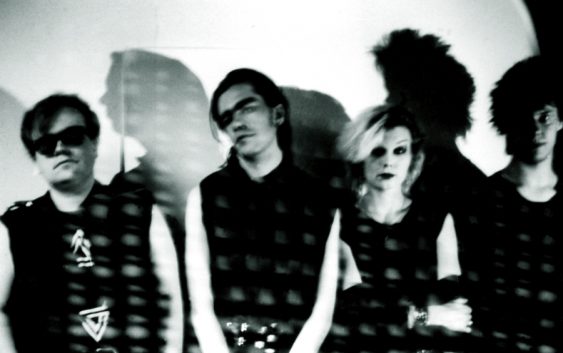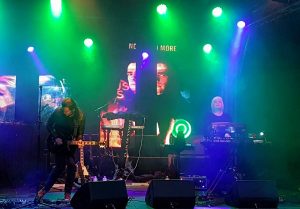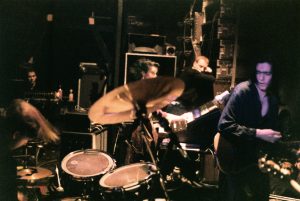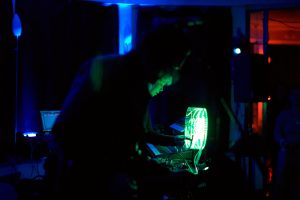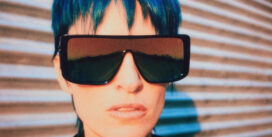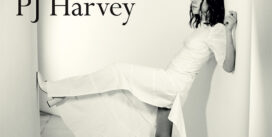1. Andy and Tina have been present on the music scene for quite a long time. When and how exactly was No More formed? What lead you to the decision to start your music career so long ago?
Tina: I don’t know if I would call it a decision.
Andy: Or a career 😉
Tina: We started in 1979 in our German hometown Kiel. Andy, Christian Darc and me were in a schoolband, but we’ve been listening to Punk and New Wave for some time. So we started No More, recruited a schoolmate, who has never played an instrument before, on bass.
Andy: We began to release our own tapes and records right away. Collaborated with other bands, started to do gigs etc. The whole shebang.
Tina: So we did until 1986 and then we called it a day.
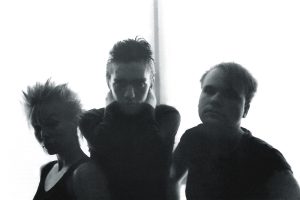 2. I hope you still remember what your passion was all about back in the early 80s. How did the flourishing post-punk, electronic and underground scene look like back then and how do you feel about being a part of it?
2. I hope you still remember what your passion was all about back in the early 80s. How did the flourishing post-punk, electronic and underground scene look like back then and how do you feel about being a part of it?
Tina: In retrospective it sometimes seems bigger than it really was but it was definitely very exciting for us.
Andy: Each and every day brought something new. We were young, naive and enthusiastic. Being part of that scene also meant that you were an outsider to the “rest” a.k.a. majority – at least at the beginning. The level of tolerance was not that high in those days. This added a little extra thrill to it all.
Tina: We were kind of separated from the rest of Germany, but the Kiel scene was very vivid at that time. There were a lot of styles: from Punk to New Wave, from Electro-Avantgarde to Rock-a-billy and everything in between.
Andy: We were trying to escape the Grey. The scene was very colourful, pre-Goth. Meeting at the monthly flea market to sell and trade records, bootlegs and annoying people around us. We became part of that lot, within weeks I was recording with No Horizon for their first (and last) record, playing on Kiel’s first big Punk festival and with No More on our first gig. It was very dynamic, very fast. That’s probably what I really miss. Nowadays it looks as if everything’s moving fast, but it isn’t.
Tina: Most of the interesting concerts were in Hamburg, so we drove down to watch Siouxsie, Cure, Bauhaus, Lydia Lunch, Birthday Party and so on. We played one of our first concerts in Hamburg at the Grünspan near the Reeperbahn and we had to transport our equipment in a small caravan. The prostitutes were sitting, more or less naked, in the windows, watching as I crashed the caravan into the garbage cans 🙂
Andy: I remember this record shop near the harbour. Every Saturday they got a new delivery from the UK. We knew the guy that ordered all the “good stuff” and so we could go through it before they put it in the store. Sometimes we would just buy a record because the cover looked cool.
Tina: Synthesizers became affordable at that time but they were still expensive, at least for us. And it was not common to have a synthesizer on stage. And most of the punks didn’t like it.
Andy: We knew the manager of the famous Jazzer Joachim Kühn who had an endorsement deal. So we got a brand new sequencer but we were too stupid to use it right, so we sold it.
Tina: He also wanted to produce “Suicide Commando” but didn’t because he didn’t like the demo recording. Later, when we recorded “A Rose Is A Rose”, we were told that he had killed himself.
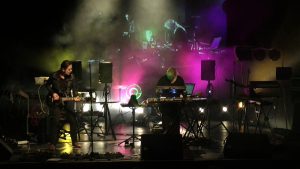 3. From today’s music perspective your hit number “Suicide Commando” from 1981 sounds rather experimental and minimalistic. How was that expression perceived back then? Lots of synth pop bands utilized the sound to create what was considered synth pop at the time. So what were your thoughts and ideas about creating music?
3. From today’s music perspective your hit number “Suicide Commando” from 1981 sounds rather experimental and minimalistic. How was that expression perceived back then? Lots of synth pop bands utilized the sound to create what was considered synth pop at the time. So what were your thoughts and ideas about creating music?
Tina: We didn’t think so much about technical things, we just wanted to express THAT feeling of the moment. Synth pop was not what we were aiming at.
Andy: We had that song and everybody said it could be a hit. But the arrangement didn’t work, the demo recording didn’t work. On the final recording we seem to have done the right “tricks”.
Tina: But we hardly sold any copies when it came out. Things changed at the end of ’83 and in ’84 when it became known, esp. in Belgium and the Ruhrgebiet.
Andy: We were a 3 piece band at that time and had this drum synthesizer and that simple drumbox. That changed the sound and we wanted it to sound as cold as possible.
4. You were certainly influenced by other contemporary artists. Did any name in particular play an important role in your creative process? What were you drawn to back then in terms of sound or other aspects of art?
Tina: The combination of synthesizers and guitar in early Ultravox, the experimental sound of Public Image Ltd., the style of the Banshees’ first line-up, the elegance of Japan.
Andy: The sound of alienation on Bowie’s Heroes and Low, Wire’s minimal dark-pop, Derek Jarman’s Endzeit movie Jubilee, Helmut Newton’s photography, Wolfgang Bülds movie “Brennende Langeweile” featuring The Adverts, everything by Brian Eno, the smell of piss and beer when you entered the rehearsal room of No Horizon, …
Tina: Feeling like the Mods in Quadrophenia.
5. UK and USA had strong music industries that supported what we consider today “underground” music and gave opportunity to some artists to become legends. How were things going on in Germany – one of the countries that also gave us some music legends?
Andy: Concerning Punk and Post-Punk, the German music industry had no clue at first. Most of it was D.I.Y. When it became more successful and popular, it went for the stupid rip-off kind. Turned that Neue Deutsche Welle thing into something incredible ridiculous.
Tina: There were exceptions but those were the 80s.
Andy: In the UK things were going down the drain as well, musically and stylewise. At least from ’83 onwards, things were going bad again.
6. In your biography you funnily mention your “short hiatus” of 22 years before you decided to go back on stage. How did you feel about getting back into “business”? Has anything changed for you when it comes to passion towards music and creating, playing live?
Andy: Going back on stage was at least as exciting as in the “old days”. We were not so naive anymore, so we knew what could go wrong.
Tina: We say that in every interview: playing live is so much more fun than in the 80s. The audience is better and we are better too 😉
Andy: We are as D.I.Y. as we were back then, but on a much higher level. We have more skills and far better equipment, but the creative process still starts from scratch – each song, each album – it’s the same fight, the same excitement, the same frustration, the same fun.
Tina: When we started, people told us that the business was easier in the past. That’s what they tell us now. So we don’t care about such things anymore.
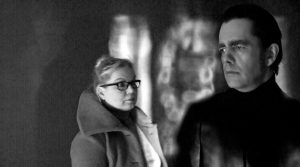 7. By the time “Midnight People & Lo-Life Stars” was released you were not “young Germans who appear to have fallen out of Lou Reed’s Berlin album” any more. But surely you felt that passion again when you started playing actively across Europe and also when you went back to song writing and recording. Did you feel you just picked up where you had left off or was it more like opening a complete new No More chapter?
7. By the time “Midnight People & Lo-Life Stars” was released you were not “young Germans who appear to have fallen out of Lou Reed’s Berlin album” any more. But surely you felt that passion again when you started playing actively across Europe and also when you went back to song writing and recording. Did you feel you just picked up where you had left off or was it more like opening a complete new No More chapter?
Tina: One of the reasons we stopped for such a long time was that we couldn’t imagine continuing where we left off. There were reasons for stopping and so No More was over.
Andy: When we did this exhibition at the museum in Kiel about the Post-Punk scene in Kiel in 2007, we took a close look at the beginnings. We realized that 1979, the beginning, would be a good starting point.
Tina: Now, after making the same mistakes again – only better this time – we are at a point where we come to unknown territory.
8. Released in 2012, “Sisyphus” is a brilliant album where you can hear such great diversity that makes a perfect unity. How does No More succeed in making the album that sounds like a complete story? I feel as if your inspiration has never stopped. Where were your minds and hearts while you were creating “Sisyphus”?
Tina: That’s a nice thing to say. All the new albums have a theme, a concept – not a strict one, but something that combines the songs loosely with each other.
Andy: We’ve always been listening to a wide range of styles but the things we like seem to have something in common. Sometimes you can find similar things in a 60s beat song and a Techno track.
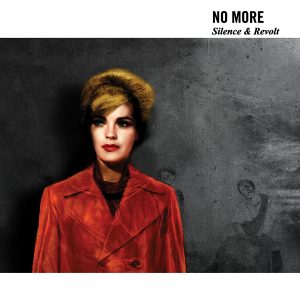 9. In 2015 there was yet another marvellous piece of your work; this time it was “Silence & Revolt”! I had a great pleasure reviewing the album and I was really excited a lot while listening to it. I feel I understand the title and what it means in the context of the album, but I would really like if you could share it with our readers and tell them a bit more about the ideas that you expressed with that release regarding the subjects of your lyrics?
9. In 2015 there was yet another marvellous piece of your work; this time it was “Silence & Revolt”! I had a great pleasure reviewing the album and I was really excited a lot while listening to it. I feel I understand the title and what it means in the context of the album, but I would really like if you could share it with our readers and tell them a bit more about the ideas that you expressed with that release regarding the subjects of your lyrics?
Andy: I had a bunch of ideas for the lyrics when we started writing this album. First song was “Silent Revolt” about Erdem Gündüz – “The Standing Man” – and the revolt around Istanbul’s Taksim Square. So this set the tone and soon we realized that these apparently conflicting ideas appeared in a lot of the songs. They are also important in Albert Camus’ philosophy and that was a starting point for “Sisyphus”.
10. Soundwise, what do you personally think about “Silence & Revolt”?
Tina: More Pop than ever.
11. Even though you remained true to your own expression, are there any new trends in music that you find exciting today as much as you did back in the “old” days? What are your thoughts about today’s music scene in general?
Andy: I don’t go for trends or scenes anymore, at least not for trends that are communicated as trends. I try to get what makes me wanna listen to a certain “type” or way of expression or style.
Maybe I’m not a mainstream person but I’m not that far out, so there will be enough people who will share my likes and dislikes.
12. Has anything about playing live changed for you during the years? How do you feel on stage today?
Tina: Like I said before, it’s better than before. No-one has to play dead cool anymore.
Andy: Although there are still some bands who do.
Tina: And that’s funny to watch.
Andy: I think that we now know what’s it all about. But on the other hand that’s what we thought in the 80s too 😉
13. Do you find that there are still some devoted fans have been following you since your early days and do you think that some new fans, who were maybe not even familiar with your music history, started following you after your more recent work was released?
Tina: Both is true. Plus the people who knew “Suicide Commando” but didn’t know that it was us until now.
14. Can you tell us something about your M’era Luna Festival experience? How was it to play at such a large festival? Do you prefer cosier atmosphere of the smaller venues over the festival ones?
Tina: This has already been some time ago and it was almost surreal. We opened the festival on the main stage at 11 o’clock in the morning, played 30 minutes, took the money and were at home in the afternoon.
Andy: There were not that many people in front of the stage. So the stage seemed a bit oversized esp. for a duo in broad daylight.
Tina: We have learned in the meantime how to handle a bigger crowd on a festival. You always have to react to the atmosphere that is created by the audience and the venue – and to channel it in the right way – no matter if it’s a big festival or a small club.
Andy: There are two things I really hate at festivals: the toilets and the “clap your hands” bands.
15. You have some live dates announced for the near future. Is there any place in particular you would like to play, but still haven’t?
Andy: A lot. Istanbul, Beirut, Tel Aviv, Bukarest, New York and Lisbon come to my mind. I guess we won’t play the first two or three within the next few years due to the political situation. But I think all these places have a special atmosphere I would like to discover.
16. After your great release last year, what awaits us in future? Have you got any “secrets” to share?
Tina: There will be a vinyl compilation in autumn. It will feature reworked versions of songs from the last three albums.
Andy: Proper songs, no “remixes”.


